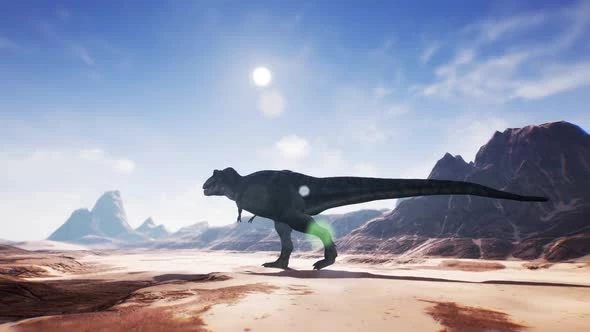The oldest two-legged dinosaur ever discovered in Africa was found in Zimbabwe
Blood substitute restores organs hours after the heart stops beating / What makes the human brain different? Study reveals clues
In northern Zimbabwe, fossils of a new species of plant-eating dinosaur have been discovered. It is part of a massive collection of Late Triassic fossils that could help us understand how the climate of the time influenced the dispersal of early dinosaurs.
This fossil is the oldest dinosaur fossil ever discovered in Africa. It has been identified as a species of sauropodomorph, ancestors of the four-legged sauropod dinosaurs with long necks and large bodies. The dinosaur, named Mbiresaurus raathi, stood at least one meter tall, ran on two legs, weighed about 30 kilograms, and had a small head, a long neck, and leaf-shaped teeth.

Artistic reconstruction of Mbiresaurus raathi, which has been discovered in Zimbabwe.
On the second day of an expedition to Mbire in the Zambezi Valley in 2017, Christopher Griffin of Yale University discovered a dinosaur femur protruding from the ground, dug around it, and uncovered a hip bone.
“I kept digging, got more of the team to help out, and we recovered nearly the entire skeleton,” he says. “The rocks it was found in have been interpreted as a river deposit, and it may have been buried in a small-scale flood.”
On the basis of the presence of other fossils in the assemblage, the team has dated M. raathi to approximately 230 million years ago, which corresponds to the Carnian stage of the Late Triassic. Historically, Zimbabwe was located much further south than it is now and was a part of the massive supercontinent Pangaea.
Scientists hypothesize that latitude played a significant role in Pangaea's climate due to the reduced influence of the ocean on the single landmass. In contrast to the more arid and unstable lower latitudes, higher latitudes, such as those in which Zimbabwe was located at the time, likely had higher humidity and more vegetation.
It is believed that these climatic bands governed the distribution of early dinosaurs, with the majority inhabiting the temperate climate of southern Pangaea. It is believed that dinosaurs avoided the harsh deserts to the north of this region, to which they were poorly adapted.
“We would expect that you could draw a straight line joining northern Argentina, southern Brazil and India at this time, and everywhere along that line would have a very similar climate. This imaginary line goes right through Zimbabwe,” says Griffin.
This climatic line was utilized by Griffin and his team to pinpoint a possible source of fossils. A 1992 paper by Michael Raath reported the discovery of rhynchosaur fossils, a Carnian-aged reptile, in the Pebbly Arkose Formation of northern Zimbabwe's Dande region.

It is believed that dinosaurs avoided the harsh deserts to the north of this region, to which they were poorly adapted (Illustrative image).
Raath also reported a single bone fragment that he believed belonged to an early dinosaur. These discoveries indicated that Zimbabwe possessed rocks of the appropriate age to preserve fossils from this period.
Before visiting sites to search for fossils, the team used a geological map of the region and Google Earth satellite images to pinpoint where these rocks were exposed at the surface. At one site, researchers discovered hundreds of bones, the majority of which belonged to rhynchosaurs but also dinosaur remains. Here, Griffin discovered the protruding femur.
Two expeditions in 2017 and 2019 uncovered a collection of animal remains, including those of a large carnivorous herrerasaurid dinosaur, ancestors of mammals known as cynodonts, and crocodile ancestors known as aetosaurs. M. raathi is older than the occasional dinosaur bones and dinosaur footprint trackway found in Zimbabwe's Zambezi Valley.
“What this means is that Zimbabwe records the transition from the earliest dinosaurs, when they were more rare, to a time when dinosaurs had become much more abundant and dominant,” says Griffin.
The latest discovery, according to Anusuya Chinsamy-Turan of the University of Cape Town in South Africa, provides a unique glimpse into the faunal diversity that existed in this region of northern Zimbabwe 230 million years ago. “The fact that the fauna resembles other similar-aged Carnian deposits in Argentina, as well as in Brazil and India, strongly supports the hypothesis that the distribution may be linked to climatic barriers,” she says.
In July, she and her coworkers described a new iguanodontian dinosaur (Iyuku raathi) discovered in the Eastern Cape Province of South Africa. She describes the discovery of two dinosaur fossils in Africa within a month as "extraordinary." The new fossil discovery in Zimbabwe comes as the Australian company Invictus is expected to begin oil and gas exploration drilling across a vast portion of the fossil-rich Cabora Bassa Basin next month. “It is my earnest hope that the necessary agreements are in place for the safety of the fossils, as well as for rehabilitation post exploration,” says Chinsamy-Turan.
Journal reference: Nature, DOI: 10.1038/s41586-022-05133-x
End of content
Không có tin nào tiếp theo
